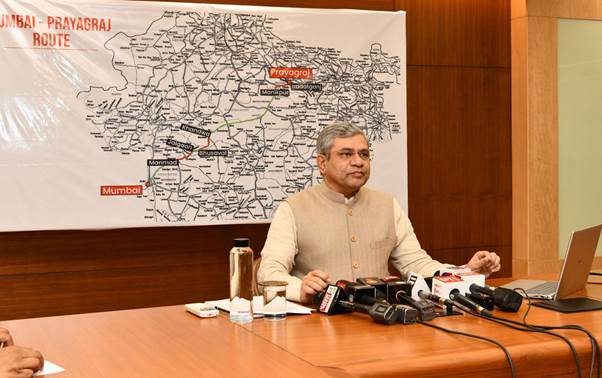India’s railway network, the lifeline of its economic and social fabric, is set to witness a transformative expansion with the approval of three major railway projects by the Cabinet Committee on Economic Affairs (CCEA). These initiatives will span Maharashtra, Madhya Pradesh, and Uttar Pradesh, promising to revolutionize connectivity, logistics, and socio-economic growth across key regions. With a total length of 375 km, these multi-tracking projects represent a critical step in India’s infrastructure development journey.
Overview of the Railway Expansion Projects
The three significant projects approved are:
- Jalgaon–Manmad 4th Line (160 km)
- Bhusawal–Khandwa 3rd & 4th Lines (131 km)
- Prayagraj (Iradatganj)–Manikpur 3rd Line (84 km)
These projects are strategically designed to enhance connectivity between Mumbai and Prayagraj, facilitating seamless movement for both passengers and goods. The enhanced capacity is expected to decongest existing railway routes, boost economic growth, and support emerging industries.
Key Benefits of the Railway Projects
Improved Logistics and Freight Movement
These projects will strengthen the logistics infrastructure by connecting key regions such as Purvanchal, Mumbai, and Varanasi. The corridor will serve as a feeder to the Eastern Dedicated Freight Corridor (EDFC), enabling efficient transportation of agricultural and industrial goods. Improved connectivity to major ports like Jawaharlal Nehru Port Mumbai and the upcoming Vadhwan Port will further facilitate international trade, positioning India as a global logistics hub.
Support for Farmers and Agricultural Development
The innovative Shetkari Samridhi Rail, introduced from Deolali to Danapur, exemplifies how rail services can directly benefit farmers. This train, designed for flexible agricultural transport, allows farmers to ship varying quantities of produce efficiently. Its 200% occupancy since inception underscores its success, prompting plans for similar services in other regions.
Economic and Environmental Impact
With an investment of approximately ₹7,927 crore, the projects are poised to drive significant economic benefits, including the incremental loading of 50 million tons of cargo annually. Additionally, the reduced reliance on diesel is projected to save 15 crore litres of fuel per year, cutting 271 crore kilograms of CO2 emissions, equivalent to planting 15 crore trees. These green initiatives align with India’s climate goals while reducing logistics costs.
Advanced Safety with Kavach Technology
The railway projects are accompanied by advancements in safety technology. The introduction of Kavach Version 4.0, an upgraded Automatic Train Protection (ATP) system, ensures higher safety and operational efficiency. The Ministry has already equipped 1,000 km of railway lines with this technology, with plans to scale up nationwide within six years. This swift deployment highlights India’s commitment to leveraging cutting-edge innovations in rail safety.
Key Features of Kavach 4.0
- Enhanced train collision prevention mechanisms.
- Real-time monitoring and automated braking systems.
- Efficient installation process, requiring just 22 hours per locomotive.
The system is operational in key routes like Sawai Madhopur-Kota and is undergoing certification for the Mumbai-Vadodara corridor. With over 10,000 locomotives set to be equipped with Kavach, the initiative sets a global benchmark for rail safety standards.
Boosting Tourism and Cultural Connectivity
The railway expansion is expected to significantly enhance tourism, particularly to religious and cultural landmarks. Improved connectivity will facilitate easier access to destinations such as:
- Jyotirlingas: Trimbakeshwar (Nashik), Omkareshwar (Khandwa), Kashi Vishwanath (Varanasi).
- Pilgrimage Centers: Prayagraj, Chitrakoot, Shirdi, and Gaya.
- UNESCO World Heritage Sites: Ajanta and Ellora Caves, Khajuraho.
- Other Attractions: Yawal Wildlife Sanctuary, Devgiri Fort, Asirgarh Fort, and Keoti Falls.
These enhanced links will not only promote cultural exchange but also stimulate local economies through increased tourism.
Strategic Importance of the Rail Projects
Maharashtra (North Maharashtra and Khandesh Region)
The addition of the Jalgaon–Manmad 4th line and Bhusawal–Khandwa 3rd & 4th lines will improve intra-state connectivity. This is critical for industries and agriculture in regions like Nashik, known for its wine and horticulture.
Madhya Pradesh
Improved rail infrastructure will support industrial hubs and enhance access to natural resources. The Bhusawal–Khandwa section is expected to serve as a lifeline for industries relying on efficient transportation.
Uttar Pradesh (Purvanchal Region)
The Prayagraj–Manikpur line will cater to both passenger and freight needs in Purvanchal, fostering connectivity with Mumbai and Varanasi. This will also serve as a critical link for the Mumbai–Howrah Golden Diagonal.
A Vision for the Future
India’s ambitious railway expansion plans signify a bold step toward sustainable development and economic self-reliance. By bridging regions, reducing logistics costs, and promoting tourism, these projects exemplify the transformative power of infrastructure investment. With the integration of advanced safety systems like Kavach and a focus on green energy, the Indian Railways is poised to lead the global charge in modern, efficient, and environmentally friendly transport systems.
Read more at Travel Mail | Follow us on Facebook | Twitter | and Instagram for on-the-go news

